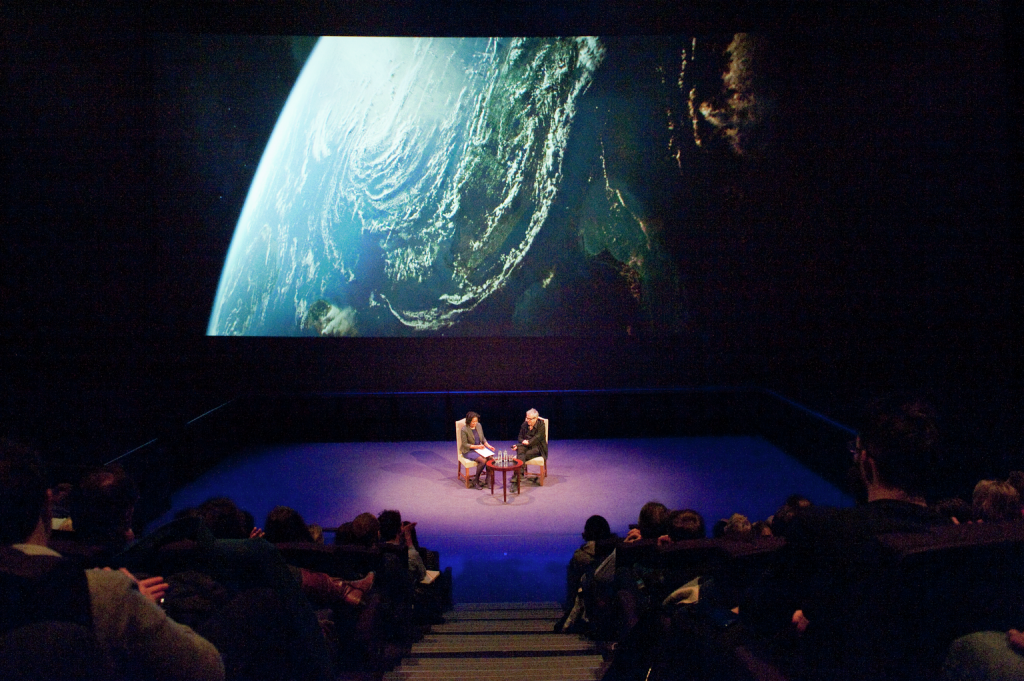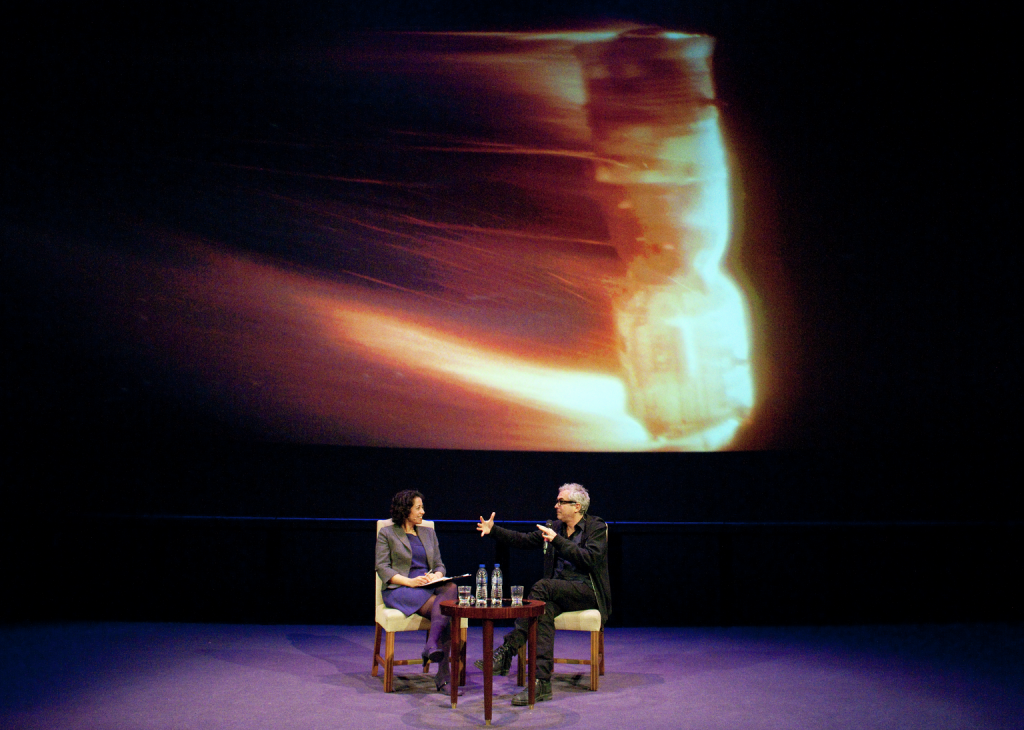Visitors to the Museum were treated to a special evening with Oscar-winning director Alfonso Cuarón last week as he discussed his space thriller Gravity with the journalist and broadcaster Samira Ahmed, Visiting Professor of Journalism at Kingston University.
Gravity received ten Oscar-nominations and won seven, including Best Director for Cuarón, who told the packed IMAX audience that he does not regard the movie as science fiction or fantasy.
Instead, the Bafta-winning director prefers to call it “a thrilling drama’ about the plight of Dr. Ryan Stone (Sandra Bullock) and her personal journey of redemption.
When it comes to the origins of the movie, Cuarón said that he had been much more influenced by the reality of space exploration than sci-fi. As a child, he had been gripped by Marooned, a 1969 American film directed by John Sturges and starring Gregory Peck, Richard Crenna, David Janssen, James Franciscus, and Gene Hackman about three astronauts who become stranded in space and subsequent rescue by the Soviets. ‘It was very well researched and they really took seriously the realistic approach…it is a blast.’
The relentless daisy-chain of action in Gravity was inspired by another script – Desierto – written by Cuarón’s son and fellow scriptwriter Jonás, which will be released as a film this year.

The first draft of their script only had one character, Dr. Stone. The father and son team wanted to make her journey during this chain reaction of challenges ‘work metaphorically’, focusing on the idea of her rebirth in the hostile environment of space.
Earlier that night I took Cuarón around the Cosmonauts exhibition and he pointed out how the astronauts sit in custom-moulded seats to adopt the fetal position within a descent module such as a Soyuz, which can be regarded like a womb, while spacewalkers were tethered by a glorified umbilical cord as they floated in the void.

But relying on a single lead character ‘proved to be a bit self-conscious’, contrived, even tedious, he admitted. That is when he and his son started to develop the role of a companion, the veteran astronaut Matt Kowalski, played by George Clooney.
The audience was held rapt by the four clips introduced by Samira Ahmed, starting with an accident with a Russian satellite that triggers the Kessler syndrome, named after Donald Kessler, formerly at Nasa’s Johnson Space Center in Houston. With a colleague, Kessler proposed that collisions between man-made objects in orbit could spawn swarms of junk, sparking a chain reaction that would swiftly ring the Earth with the debris from thousands of satellites. It is already ‘full of trash up there,’ said Cuarón.
Even though ‘the whole story is quite impossible (we’re not stupid)’ he told the audience, he said he still wanted it to feel authentic, based on circumstances faced in real space exploration. He spent time talking to Nasa. ‘I asked astronauts what can go wrong. They said: ‘everything’’.
Although some carped about details in the film, the Apollo 13 commander Jim Lovell told me that Gravity is “a marvellous creation of cinematography”. And Cuarón was careful to explain that sometimes, paradoxically, the real thing looked too unreal for Hollywood. In the case of the spacesuits, for example, they chose an older ‘last season’ design because the latest versions looked too ‘science fiction.’
Kowalski also gossiped much more than real-life astronauts to contrast with Bullock’s ‘shut up’ character. He added that he felt obliged to let George natter because ‘he’s so charming.’
In making the film, Cuarón had to overcome many technical challenges. Only at the last moment did he tell Bullock, who was not keen on flying, that she did not have to film in a so-called ‘vomit comet’ (a specially fitted plane that climbs and dips to simulate weightlessness, often with unfortunate effects). In this way, he hoped that she would be more receptive to endure the pain of being suspended on 12 wires like a glorified marionette to simulate microgravity. It was like something out of ’Fifty Shades of Grey’ he joked.
Bullock had to work out for four months and practiced with professional puppeteers, from the play War Horse, to be fit enough to film the fire sequence scene. ‘Took us forever to figure out how to do it,’ explained Cuarón, explaining that it took robots, a specially built rig and simulating the complex movements of belts and tethers. The end result shows her floating and twirling through the space station during the sequence, filmed in a single fluid shot.
Not all effects were high tech. For the final, lengthy re-entry sequence, Bullock was jolted and shaken around in a capsule that sat atop of pneumatic tyres as the film crew jumped up and down. In this way, the movie recreated her thundering passage through the atmosphere back to Earth, which Cuarón likened to riding a ‘rodeo bull’. To help build the emotional climax of Gravity, he added music, sans percussion.

He also admitted to Samira Ahmed that the movie cinematographer Emmanuel Lubezki was ‘so upset with me’ when he edited out his favourite moment. On the cutting room floor lies a scene in which Kowalski and Stone see a Soyuz approaching them and think, wrongly, that it was a rescue mission. As they gazed at each other ‘helmet to helmet’ bathed in sunlight, they ‘lose it for a moment’. ‘It was a good scene, I love it,’ said Cuaron. But to maintain the emotional momentum, and prevent the movie from becoming repetitive, it had to go.
The stunning cinematography was brought to life with the help of British visual effects company Framestore, and was informed by discussions with scientists, for instance about how flames appear in space (spherical and ‘quite beautiful,’ he said) and earlier real-life incidents, notably on the Mir space station. Bullock would even ring up Nasa astronaut Catherine Coleman as she orbited in the International Space Station for advice and insights.
The studio attempted to persuade Cuarón to end Gravity with a dramatic helicopter rescue of Bullock’s character, or even with Dr. Stone rekindling love interest with an individual in mission control. He rejected the overblown and cheesy in favour of a simple shot of ‘a little house in the distance.’
The event was the latest in a series to celebrate Cosmonauts, the most significant exhibition of Soviet and Russian space artefacts ever staged outside Russia. Alfonso Cuarón told the IMAX audience the exhibition is ‘amazing…the Soviet space programme has been very, very underrated. It is so great that it is finally celebrated.’
As he left the auditorium, the audience watched a video of the cosmonaut who deserves to be the original inspiration for Dr Stone: the great Valentina Tereshkova. Tereshkova was the first woman in space, the first civilian and remains the only woman to have flown solo in space.
Roger Highfield is Director of External Affairs at the Science Museum.